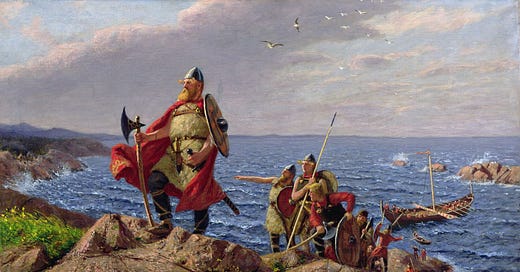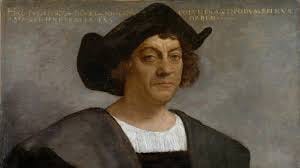A Viking Reached America 500 Years Before Columbus—But No One Talks About It
I Traveled to Iceland and Found Out Everything We Learned About Columbus Is Wrong
When we think about the so-called "discovery" of America, one name tends to dominate the conversation: Christopher Columbus. Even though we know he was far from the first person to arrive in the Americas (bested by indigenous Americans by millennia), he is still generally thought of as the first European to arrive. But what if I told you that nearly 500 years before Columbus set foot in the Caribbean, a Viking explorer named Leif Erikson had already made landfall in mainland North America?
I came across countless references to this legendary Norse explorer during my recent trip to Iceland. From the towering statue of Leif Erikson in Reykjavík, which stands proudly in front of the iconic Hallgrímskirkja Church, to the detailed exhibits at the Viking Museum, it became clear that Iceland takes great pride in its connection to Erikson. And for good reason. His journey fundamentally challenges the narrative of who first reached the shores of the so-called "New World."
Leif Erikson: The First European in North America
Leif Erikson was born around 970 CE in Iceland, the son of Erik the Red, a Norse explorer who founded the first Viking settlements in Greenland. Leif, however, was destined to push further west. Around the year 1000 CE, he set sail with a crew of about 35 men and reached a land he called Vinland, what many historians now believe to be Newfoundland, Canada.
Unlike Columbus, whose arrival marked the beginning of centuries of European colonization and exploitation of Indigenous peoples, Erikson and his crew did not establish a permanent settlement. They built temporary shelters, explored the land, and documented the rich natural resources they found, including salmon-filled rivers and grapevines, hence the name "Vinland." After one winter, they returned to Greenland, and while later Viking expeditions attempted to return, none established lasting communities in North America.
For centuries, the story of Leif Erikson's journey was preserved through Norse sagas, oral histories that were later written down in medieval Iceland. But for a long time, there was little physical evidence to back them up. That changed in 1960, when archaeologists Helge and Anne Stine Ingstad uncovered Viking ruins at L’Anse aux Meadows in Newfoundland—proving that Norse explorers had indeed set foot in North America long before Columbus.
Why Don’t We Celebrate Leif Erikson Like Columbus?
Despite his remarkable achievement, Leif Erikson’s legacy in American culture has never quite matched that of Columbus. One reason is that Columbus’ voyages directly led to sustained European colonization, while Erikson’s did not. Another is that Columbus had powerful advocates, particularly Italian American communities and the Catholic Church, who lobbied for creating Columbus Day as a federal holiday in 1937.
Watch my National Geographic Series, Hidden History to learn the story of the Italian American Massacre that caused "Columbus Day” to become a National Holiday!
Leif Erikson, on the other hand, was championed by Scandinavian Americans, who pushed for a day in his honor. In 1964, President Lyndon B. Johnson officially recognized October 9th as Leif Erikson Day, but unlike Columbus Day, it never became a national holiday. The debate over these figures even had racial undertones—many proponents of Leif Erikson in the late 19th and early 20th centuries framed him as a "whiter" alternative to Columbus, a stance fueled by nativist and anti-Catholic sentiments at the time.
But in recent years, as more Americans rethink the glorification of Columbus due to his role in Indigenous genocide, some have looked to figures like Leif Erikson as an alternative. However, even the Viking arrival in North America was not without conflict—later expeditions clashed violently with Indigenous peoples. While the Vikings did not stay, their presence was still an early example of European encroachment on Native lands.
Rewriting the Narrative
So, did Leif Erikson "discover" America? Not exactly. The land was already home to thriving Indigenous civilizations long before either Vikings or Spaniards arrived. But he was the first known European to reach North America, and his journey offers an alternative to the imperialist myth that Columbus and the Spanish Empire "found" a new world.
Why Independent Voices Matter More Than Ever
History can’t hide, but it can be erased if we don’t fight for it.
That’s why I’m asking you to support independent history, journalism, and truth.
🚨 Become a paid subscriber to my newsletter, History Can’t Hide. 🚨
For just a few dollars a month, you help me continue exposing stories that powerful institutions would rather keep buried. You ensure that history remains in the hands of the people—not in the hands of a government that decides who gets to speak and who doesn’t.
Your support helps me continue to:
📚 Invest in high-quality research to bring you the most accurate and well-sourced history content.
🎥 Expand production—I want to create longer, more in-depth videos across platforms like YouTube and video podcasts.
💼 Hire young historians and researchers, especially from underrepresented communities, to help uncover more stories.
✈️ Travel to historical sites and conduct primary source research for deeper storytelling.
The stakes are high. Trump is proving that he will silence anyone who challenges him. Let’s make sure the truth gets louder. 👇🏾
References
Archer, Peter. The Book of Viking Myths. Avon: Adams Media, 2017.
Britannica Educational Publishing. Biographies of the New World: Leif Eriksson, Henry Hudson, Charles Darwin, and More, edited by Michael Anderson. New York: Britannica Educational Publishing, 2013.
Little, Becky. “Why Do We Celebrate Columbus Day and Not Leif Erikson Day?” National Geographic, October 11, 2015.
The Mariners' Museum. "Leif Eriksson." The Ages of Exploration, 2025.
Waxman, Olivia B. “The Troubling History of the Fight to Honor Leif Erikson—Not Columbus—as the Man Who ‘Discovered America’.” TIME, October 5, 2018.









I agree with Ibis that Leif Erickson is talked about, especially in Duluth, Mn where we have a park named after him and to which people sailed in a replica boat in the 1920’s. http://leiferiksonvikingship.com/portfolio-items/history/
I’ve heard this name before but definitely didn’t realize he was a Viking explorer! so interesting!!